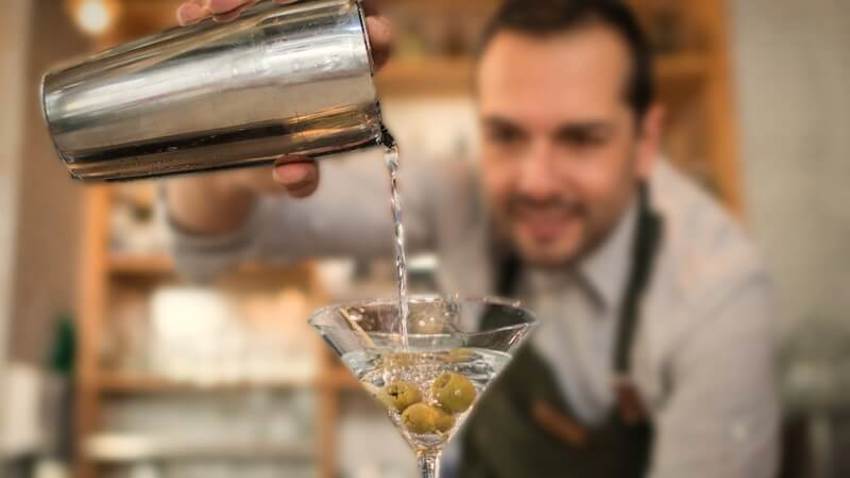
With cocktails, service is key. Poorly presented cocktails are a sure fire way to limit the amount you can charge or worse, turn customers away altogether. Amongst the 'turn-off' reasons cited by non-cocktails drinkers were: bar staff struggling to make cocktails and being overly time-consuming waiting for one to be served. All of these issues can be remedied and, as cocktail drinkers spend £28 more out of home than non-cocktail consumers, it is worth it too.
Firstly, there are a few layout basics and organisation tips that can help you maximise efficiency when producing your cocktails. “Most importantly in a bar environment is having a clean service area,” says Johnnie Walker, Brand Ambassador and 2015 Diageo world Class winner Ali Reynolds, “all the essential equipment and everything you could possibly need should be in arms reach”.
"Most importantly in a bar environment is having a clean service area.”
By Ali Reynolds, Johnnie Walker
Having a set area where cocktails are produced may keep things tidy but can lead to bottlenecks in busy periods, so make sure you have more than one set of equipment needed and keep it in separate locations on your bar. On your back bar or in your speed rails, repeat the most frequently used ingredients – this may be difficult in bars with a wide range of spirits, so keep the less frequently, most used ingredients in easy reach of both cocktail stations.

As Remy Martin’s Jack Charlton says, “simplicity is key, don’t overcrowd your bar station with things that are not needed”. Don’t block any space with non-salable items such as milk, mugs, cleaning products, stationary etc. If it isn’t for sale it shouldn’t be seen! “The most vital pieces of equipment are a tin on tin shaker, a good knife, hawthorn and a fine strainer, bar spoon and a jigger. These are the only tools you need to make some of the best cocktails. It’s best to keep things simple” says Ali.
“The most important part, and maybe I shouldn’t be saying this, is that it’s not about the drink. The drink is simply just the middle point between two people talking to each other. Everything is about the customer service” states Johnnie Walker's Ali Reynolds and of course, he’s right! Make sure you know your cocktails of by heart. Customers like to know the drink is being created by someone knowledgeable about the serve. “Remembering that the guest’s needs are paramount. Listening and being attentive is so important” adds Jack.
“Serve a cocktail with love and a smile. Remember that 93% of communication is non-verbal! 55% is body language so remember eye contact, open gestures and make them feel like you are welcoming them to your home” says Remy Martin Brand Ambassador Jack Charlton, “always put yourself in their shoes and think ‘how would I like to be treated?’”. “It’s so key to make people feel at home and make sure they leave with a sense they could be anywhere in the world,” says Ali, “being wherever they are with that cocktail is their escapism from everyday life and that fantastic cocktail service is vital”.

Building that personal rapport is an often forgotten element of cocktail service – it doesn’t have to be a deep and intimate connection however! Customers are increasingly spirit savvy and increasingly turned off by perceived lack of knowledge by staff. The On-Trade should be no different from any other business that sells a product. Having a little bit of cocktail knowledge makes you and your outlet look more professional in the eyes of your customers – they will start to trust your offer.
“Customers are increasingly turned off by perceived lack of knowledge by staff.”
Ensure that all of your staff have tried each of the cocktails on your list and know the ingredients. Staff should have a descriptor in mind for each cocktail such as sweet, fruity, tart, dry or boozy. An extra fact about each of the drinks will also go down well with customers, especially for cocktails with a history to tell.
Always seek to help the customer with their decision. If a customer is seen looking at a cocktail list, ask them what kind of drink they like and recommend accordingly with a cocktail that the customer will enjoy and offers you a better margin. Staff should also look to spot an opportunity to recommend a cocktail. For example, when someone is celebrating a birthday, why not recommend a round of cocktails?

And when it comes to the drink itself? “There are three equally important things to remember here” says Ali, “service with a smile is an obvious one but doesn’t make it any less important. Secondly, the bottom third of the glass is for you, the other two-thirds are for them - this is one in particular that annoys me. Thirdly, always serve it with a coaster or napkin unless the glass has a stem”.
There are also some rules we believe are the most important elements of a great cocktail serve. Ensure you’re using the right glassware for the cocktail serve and that it’s squeaky clean. The glass should always be filled to the brim with ice or if the cocktail isn’t served with ice, ensure it is chilled with ice and water beforehand. Taste as you go to make sure it isn’t the customer that is the one to find out something isn’t right. Finally, always garnish it has an instant effect on the look of the drink. Although as Jack Charlton says, “learn the rules like a pro, so you can break them like an artist”.


